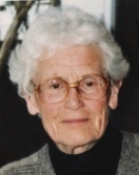In memory of Ester Einhorn
31 October 1913 - 28 April 2010

Lasting face of a generation
of
Jewish refugees
The death of Ester Einhorn marks the end of an era. She was almost the last of a generation of Jewish-born refugees who arrived from Central Europe in the wake of the Nazis' rise to power.
The celebration of her life at Old St Paul's was attended by an unusually large gathering for one of such an age. Most of these people were not of her generation, a testimony to her capacity for warm and loyal friendship.
Ester and her husband Helmut's relationship with a group of refugees and close New Zealand friends formed the Einhorn daughters' extended family as they were growing up, in the absence of actual grandparents, aunts or uncles.
The immense contribution of this group of immigrants to the culture of their adoptive homeland has been honoured in recent conferences and publications. Their contribution spans food, art, music, architecture and design, and concern for the natural environment.
It is Ester Einhorn who speaks for this wave of immigrants to New Zealand in the film Crossings at Te Papa.
Ester was born in Rotenburg an der Fulda, a charming medieval town in the green rolling hills of central Germany. She was the third and youngest child of Wyla and Siegfried Katzenstein. Her father was a merchant and town councillor; her mother a devoted housewife and mother.
Ester always recalled an extremely happy childhood, especially her schooling at the Jakob Grimm Grammar School. She graduated in 1932 as the only girl in her class, one of only two Jewish pupils to gain their Abitur (University Entrance).
It was from her father and her school, Ester always said, that she learned the central importance of tolerance. She saw it as the only way to a peaceful and socially just world, a cause to which she remained passionately committed to the end.
Sadly - and perhaps a lifelong disappointment - she was unable to pursue her dream of higher education.
Soon after the Nazis came to power they excluded Jewish students. Ester's hunger for learning and a passion to be involved in the world was all the greater for that.
Blocked from further study, she went to Berlin to find employment. It was there she met her future husband, Helmut Einhorn.
After Kristallnacht 1938, when Germany's synagogues were set alight, many Jews woke up to the fact there was no alternative but to flee.
Finding asylum was very hard. The New Zealand government sent letters to prospective Jewish refugees: "We do not think you would assimilate into our culture." Prejudice against Jews was not unique to Germany.
Ad Feedback The Einhorns were among just 1000 to gain entry. They remained forever grateful for the opportunity to live and raise two daughters in this peaceful country, whose natural environment they learned to cherish and enjoy on many tramping trips.
Indeed, Ester and the "walking ladies", led by her dear friend Elsie Beaglehole continued weekly tramps well into their 80s.
The "Einhorn house" was designed by Helmut and built in Karori in 1950. It is an icon of the modernist architecture he and other European architects introduced to New Zealand.
Ester had a hand in its design. She was mainly responsible for the transformation of the steep, gorse-covered clay bank into the lush garden that exists today.
Ester and Helmut had immense foresight, planting natives at a time when others were trying to emulate English gardens. Now the camellias and rhododendrons nestle in among the kowhai, lancewood, pohutukawa and puriri, with tui and fantails flitting in and out.
Ester and Helmut were deeply committed to what they - as Left-wing radicals - perceived as the democratic spirit of their new homeland.
Helmut was for years Wellington chairman of the Campaign for Nuclear Disarmament and the whole family went on Easter marches. Ester became a founding member of the New Zealand-China Friendship Society.
Ester supported Helmut in his concern for the built as well as the natural environment. Both were active in the preservation of Bolton Street Cemetery.
After his death, Ester saw to it that a seat was installed there to commemorate Helmut and his parents, who had not survived the Holocaust. She planted a tree in Helmut's memory at the Katherine Mansfield memorial, which he had designed.
Both played important roles in the Architectural Centre and the wider cultural life of Wellington, including the Chamber Music Society.
Ester was a great friend to many, without regard for differences of age, class, ethnicity or religion. Many remember her especially for the wonderful food they enjoyed at her home.
Barbara Einhorn,
Published in The Dominion Post, 10 May 2010
Top of the page | Peace Movement Aotearoa